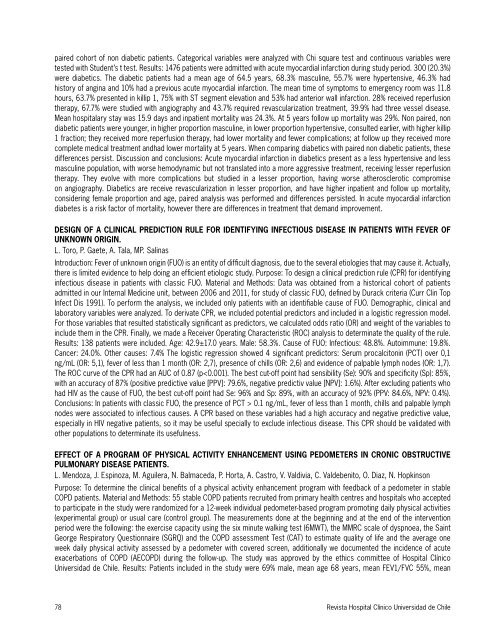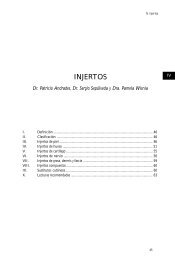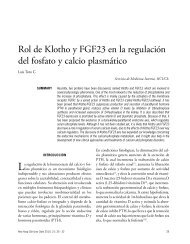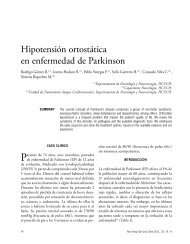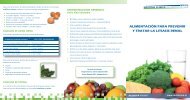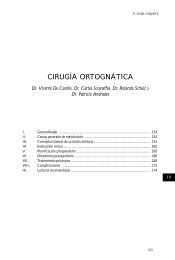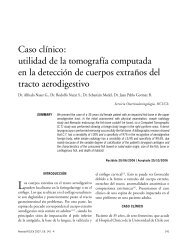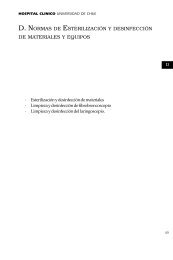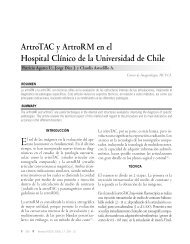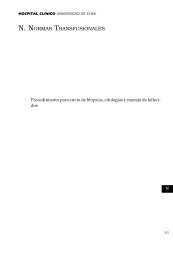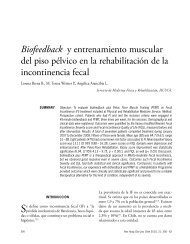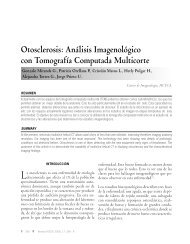Abstracts de trabajos presentados en congresos internacionales 2012
Abstracts de trabajos presentados en congresos internacionales 2012
Abstracts de trabajos presentados en congresos internacionales 2012
You also want an ePaper? Increase the reach of your titles
YUMPU automatically turns print PDFs into web optimized ePapers that Google loves.
paired cohort of non diabetic pati<strong>en</strong>ts. Categorical variables were analyzed with Chi square test and continuous variables weretested with Stu<strong>de</strong>nt’s t test. Results: 1476 pati<strong>en</strong>ts were admitted with acute myocardial infarction during study period. 300 (20.3%)were diabetics. The diabetic pati<strong>en</strong>ts had a mean age of 64.5 years, 68.3% masculine, 55.7% were hypert<strong>en</strong>sive, 46.3% hadhistory of angina and 10% had a previous acute myocardial infarction. The mean time of symptoms to emerg<strong>en</strong>cy room was 11.8hours, 63.7% pres<strong>en</strong>ted in killip 1, 75% with ST segm<strong>en</strong>t elevation and 53% had anterior wall infarction. 28% received reperfusiontherapy, 67.7% were studied with angiography and 43.7% required revascularization treatm<strong>en</strong>t, 39.9% had three vessel disease.Mean hospitalary stay was 15.9 days and inpati<strong>en</strong>t mortality was 24.3%. At 5 years follow up mortality was 29%. Non paired, nondiabetic pati<strong>en</strong>ts were younger, in higher proportion masculine, in lower proportion hypert<strong>en</strong>sive, consulted earlier, with higher killip1 fraction; they received more reperfusion therapy, had lower mortality and fewer complications; at follow up they received morecomplete medical treatm<strong>en</strong>t andhad lower mortality at 5 years. Wh<strong>en</strong> comparing diabetics with paired non diabetic pati<strong>en</strong>ts, thesediffer<strong>en</strong>ces persist. Discussion and conclusions: Acute myocardial infarction in diabetics pres<strong>en</strong>t as a less hypert<strong>en</strong>sive and lessmasculine population, with worse hemodynamic but not translated into a more aggressive treatm<strong>en</strong>t, receiving lesser reperfusiontherapy. They evolve with more complications but studied in a lesser proportion, having worse atherosclerotic compromiseon angiography. Diabetics are receive revascularization in lesser proportion, and have higher inpati<strong>en</strong>t and follow up mortality,consi<strong>de</strong>ring female proportion and age, paired analysis was performed and differ<strong>en</strong>ces persisted. In acute myocardial infarctiondiabetes is a risk factor of mortality, however there are differ<strong>en</strong>ces in treatm<strong>en</strong>t that <strong>de</strong>mand improvem<strong>en</strong>t.DESIGN OF A CLINICAL PREDICTION RULE FOR IDENTIFYING INFECTIOUS DISEASE IN PATIENTS WITH FEVER OFUNKNOWN ORIGIN.L. Toro, P. Gaete, A. Tala, MP. SalinasIntroduction: Fever of unknown origin (FUO) is an <strong>en</strong>tity of difficult diagnosis, due to the several etiologies that may cause it. Actually,there is limited evi<strong>de</strong>nce to help doing an effici<strong>en</strong>t etiologic study. Purpose: To <strong>de</strong>sign a clinical prediction rule (CPR) for i<strong>de</strong>ntifyinginfectious disease in pati<strong>en</strong>ts with classic FUO. Material and Methods: Data was obtained from a historical cohort of pati<strong>en</strong>tsadmitted in our Internal Medicine unit, betwe<strong>en</strong> 2006 and 2011, for study of classic FUO, <strong>de</strong>fined by Durack criteria (Curr Clin TopInfect Dis 1991). To perform the analysis, we inclu<strong>de</strong>d only pati<strong>en</strong>ts with an i<strong>de</strong>ntifiable cause of FUO. Demographic, clinical andlaboratory variables were analyzed. To <strong>de</strong>rivate CPR, we inclu<strong>de</strong>d pot<strong>en</strong>tial predictors and inclu<strong>de</strong>d in a logistic regression mo<strong>de</strong>l.For those variables that resulted statistically significant as predictors, we calculated odds ratio (OR) and weight of the variables toinclu<strong>de</strong> them in the CPR. Finally, we ma<strong>de</strong> a Receiver Operating Characteristic (ROC) analysis to <strong>de</strong>terminate the quality of the rule.Results: 138 pati<strong>en</strong>ts were inclu<strong>de</strong>d. Age: 42.9±17.0 years. Male: 58.3%. Cause of FUO: Infectious: 48.8%. Autoimmune: 19.8%.Cancer: 24.0%. Other causes: 7.4% The logistic regression showed 4 significant predictors: Serum procalcitonin (PCT) over 0,1ng/mL (OR: 5,1), fever of less than 1 month (OR: 2,7), pres<strong>en</strong>ce of chills (OR: 2,6) and evi<strong>de</strong>nce of palpable lymph no<strong>de</strong>s (OR: 1,7).The ROC curve of the CPR had an AUC of 0.87 (p 0.1 ng/mL, fever of less than 1 month, chills and palpable lymphno<strong>de</strong>s were associated to infectious causes. A CPR based on these variables had a high accuracy and negative predictive value,especially in HIV negative pati<strong>en</strong>ts, so it may be useful specially to exclu<strong>de</strong> infectious disease. This CPR should be validated withother populations to <strong>de</strong>terminate its usefulness.EFFECT OF A PROGRAM OF PHYSICAL ACTIVITY ENHANCEMENT USING PEDOMETERS IN CRONIC OBSTRUCTIVEPULMONARY DISEASE PATIENTS.L. M<strong>en</strong>doza, J. Espinoza, M. Aguilera, N. Balmaceda, P. Horta, A. Castro, V. Valdivia, C. Val<strong>de</strong>b<strong>en</strong>ito, O. Diaz, N. HopkinsonPurpose: To <strong>de</strong>termine the clinical b<strong>en</strong>efits of a physical activity <strong>en</strong>hancem<strong>en</strong>t program with feedback of a pedometer in stableCOPD pati<strong>en</strong>ts. Material and Methods: 55 stable COPD pati<strong>en</strong>ts recruited from primary health c<strong>en</strong>tres and hospitals who acceptedto participate in the study were randomized for a 12-week individual pedometer-based program promoting daily physical activities(experim<strong>en</strong>tal group) or usual care (control group). The measurem<strong>en</strong>ts done at the beginning and at the <strong>en</strong>d of the interv<strong>en</strong>tionperiod were the following: the exercise capacity using the six minute walking test (6MWT), the MMRC scale of dyspnoea, the SaintGeorge Respiratory Questionnaire (SGRQ) and the COPD assessm<strong>en</strong>t Test (CAT) to estimate quality of life and the average oneweek daily physical activity assessed by a pedometer with covered scre<strong>en</strong>, additionally we docum<strong>en</strong>ted the inci<strong>de</strong>nce of acuteexacerbations of COPD (AECOPD) during the follow-up. The study was approved by the ethics committee of Hospital ClínicoUniversidad <strong>de</strong> Chile. Results: Pati<strong>en</strong>ts inclu<strong>de</strong>d in the study were 69% male, mean age 68 years, mean FEV1/FVC 55%, mean78Revista Hospital Clínico Universidad <strong>de</strong> Chile


